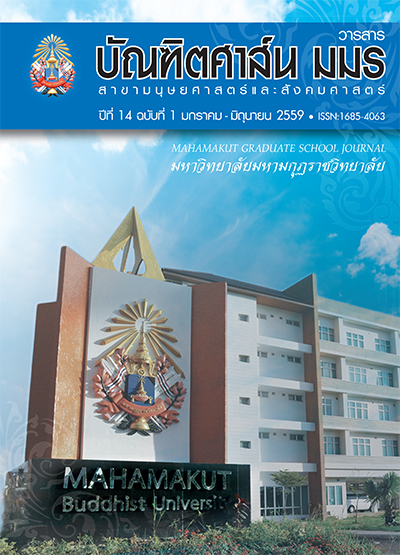ศึกษาการเจริญสังวรในการปฏิบัติวิปัสสนา ตามแนวสติปัฏฐาน 4
คำสำคัญ:
สังวร, วิปัสสนา, สติปัฏฐาน 4บทคัดย่อ
บทความวิจัยเรื่องนี้ มีวัตถุประสงค์ เพื่อ 1. ศึกษาหลักสังวร ในคัมภีร์พุทธศาสนาเถรวาท 2. ศึกษาหลักการปฏิบัติวิปัสสนาตามแนวสติปัฏฐาน 4 และ 3. ศึกษาการเจริญสังวรในการปฏิบัติวิปัสสนา ตามแนวสติปัฏฐาน 4 เป็นการวิจัยเชิงคุณภาพแบบ เอกสาร
ผลการศึกษาพบว่า สังวร หมายถึง ความสำรวม ระวัง การปิดกั้น ไม่ล่วงละเมิดทางกาย ทางวาจา มี 5 อย่าง คือ ปาติโมกขสังวร สติสังวร ญาณสังวร ขันติสังวร วิริยสังวร
การปฏิบัติวิปัสสนาตามแนวสติปัฏฐาน 4 แบ่ง ออกเป็น กายานุปัสสนา เวทนานุปัสสนา จิตตานุ ปัสสนา และธัมมานุปัสสนา เป็นคำสอนส่วนปฏิบัติ สูงสุดในพุทธศาสนา
การเจริญสังวร ในการปฏิบัติวิปัสสนาตามแนว สติปัฏฐาน 4 คือ การเจริญสติ อินทรีย์สังวรศีลย่อม หมดจดด้วยสังวร 4 อย่าง คือ สติสังวร วิริยสังวร ขันติสังวร และญาณสังวร วิธีเจริญสังวร ในส่วนของ สติสังวร ขันติสังวร และ วิริยสังวร ได้แก่ การระวังจิต การเปลี่ยนจิต สร้างความเคยชินที่เป็นกุศล และการ พิจารณาด้วยปัญญา สามารถนำไปใช้กับการปฏิบัติ วิปัสสนาตามแนวสติปัฏฐาน 4 ได้ ส่วนญาณสังวร จัดเป็นวิปัสสนาญาณและมรรคญาณ เป็นผลจาก การเจริญวิปัสสนา ปาติโมกขสังวร เป็นศีลวิสุทธิ เป็นบาทของการเจริญวิปัสสนาภาวนามีความสำคัญกับการปฏิบัติวิปัสสนาตามแนวสติปัฏฐาน 4 เช่น เดียวกัน
เอกสารอ้างอิง
ก. ข้อมูลปฐมภูมิ (Primary Sources)
มหาจุฬาลงกรณราชวิทยาลัย.พระไตรปิฎกภาษาไทย ฉบับมหาจุฬาลงกรณราชวิทยาลัย. กรุงเทพมหานคร: โรงพิมพ์มหาจุฬาลงกรณราชวิทยาลัย, 2539.
มหามกุฏราชวิทยาลัย. พระไตรปิฎกพร้อมอรรถกถา แปล ชุด 91 เล่ม.ฉบับพิมพ์ครั้งที่ 7. กรุงเทพมหานคร: โรงพิมพ์มหามกุฏราชวิทยาลัย, 2556.
พระพุทธโฆสเถระ รจนา. อรรถกถาภาษาไทย พระสุตตันตปิฎก อังคุตตรนิกาย ปัญจเอกาทสกนิบาต มโนรถปูรณีภาค 3 ฉบับมหาวิทยาลัยมหาจุฬาลงกรณราชวิทยาลัย. พุทธศักราช 2553. กรุงเทพมหานคร: โรงพิมพ์มหาจุฬาลงกรณราชวิทยาลัย, 2553.
______. อรรถกถาภาษาไทย พระสุตตันตปิฎก มัชฌิมนิกาย มูลปัณณาสก์ ปปัญจสูทนี ภาค 1 ฉบับ มหาวิทยาลัยมหาจุฬาลงกรณราชวิทยาลัย. พุทธศักราช 2552.กรุงเทพมหานคร: โรงพิมพ์มหาจุฬาลงกรณราชวิทยาลัย, 2552.
---------.สมเด็จพระพุฒาจารย์ (อาจ อาสภมหาเถร) แปลและเรียบเรียง.คัมภีร์วิสุทธิมรรค.พิมพ์ครั้งที่ 7.กรุงเทพมหานคร: โรงพิมพ์ บริษัท ธนาเพรส จำกัด, 2551.
ข. ข้อมูลทุติยภูมิ (Secondary Source)
(1) หนังสือ:
คณะกรรมการแผนกตำรา มหามกุฏราชวิทยาลัย ในพระบรมราชูปถัมภ์. พระธัมมปทัฏฐกถาแปล ภาค 1. พิมพ์ครั้งที่ 21. นครปฐม: โรงพิมพ์ มหามกุฎราชวิทยาลัย, 2553.
พระกัมมัฏฐานาจริยะ พระปณั ฑิตาภิวงศ. In This Very Life.รูแ้ จง้ ในชาตินี้.พิมพค์ รั้งที่ 8. กรุงเทพมหานคร:โรงพิมพ์ บริษัท สหธรรมิก จำกัด, 2551.
พระธรรมธีรราชมหามุนี (โชดก ญฃาณสิทธิ). วิปัสสนากรรมฐาน ภาค 1 เล่ม 1,เล่ม 2. กรุงเทพมหานคร: โรงพิมพ์ บริษัท สหธรรมมิค จำกัด, 2548.
พระสัทธัมมโชติกะ ธัมมาจริยะ. ปรมัตถโชติกะ ปริเฉทที่ 1-2-6. พิมพ์ครั้งที่ 9. กรุงเทพมหานคร: โรงพิมพ์ ห้างหุ้นส่วนจำกัด ทิพยวิสุทธิ์, 2554.
พระโสภณมหาเถระ (มหาสีสยาดอ) รจนา. พระพรหมโมลี (สมศักดิ์ อุปสโม ) ตรวจชำระ. พระคันธ-สาราภิ วงศ์ แปลและเรียบเรียง. วิปัสสนานัย เล่ม 1,นครปฐม: โรงพิมพ์ห้างหุ้นส่วนจำกัด ซีเอไอ เซ็น เตอร์ จำกัด, 2548.
. พระพรหมโมลี (สมศักดิ์ อุปสโม). ตรวจชำระ พระคันธสาราภิวงศ์. แปลและเรียบเรียง. มหาสติปัฏ ฐานสูตรทางสู่พระนิพพาน. กรุงเทพมหานคร: โรงพิมพ์ ห้างหุ้นส่วนจำกัด ไทยรายวันการพิมพ์, 2549.
ดาวน์โหลด
เผยแพร่แล้ว
รูปแบบการอ้างอิง
ฉบับ
ประเภทบทความ
สัญญาอนุญาต
บทความวิชาการและบทความวิจัยในวารสารฉบับนี้ถือเป็นความรับผิดชอบของผู้เขียนเท่านั้น บทความที่ได้รับการตีพิมพ์ในวารสารบัณฑิตศาส์น ถือเป็นลิขสิทธิ์ของมหาวิทยาลัยมหามกุฏราชวิทยาลัย ตามพระราชบัญญัติลิขสิทธิ์



